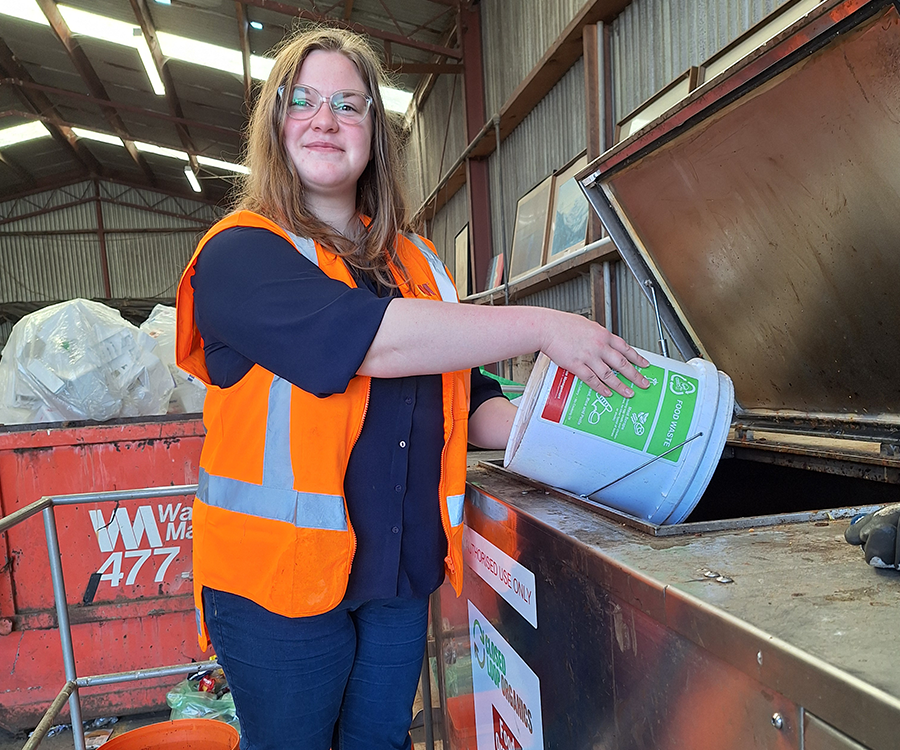
Making goodness from food waste … WM NZ (formerly Waste Management New Zealand) Waste Minimisation Coordinator Ashley King loading up the food waste digester.
A digester turned 2.33 tonnes of food waste from college kitchens and serveries into soil conditioner for University grounds in August alone – instead of the waste going to landfill and producing harmful planet-warming greenhouse gases.
Once the food waste is broken down – to about 225 kilograms last month – it is mixed into compost for the University’s Dunedin campus gardens. This is part of work with colleges in recent years to reduce food waste and divert any still produced from landfill, Custodial Services Manager Nicole Gorman says.
Sustainability Office Head Ray O’Brien says about five tonnes of carbon dioxide emissions have been prevented from entering the atmosphere by stopping about 10 tonne of food waste from entering landfill since operations scaled up earlier this year.
This approach to waste and gardening supports the University’s Pae Tata Strategic Plan to 2030’s focus on nurturing the environment, and the University’s aim to increase the proportion of its overall waste diverted from landfill to 50 percent – it is currently diverting about 20 percent.
Nicole says the waste was coming from just two colleges at the start of the year, Te Rangihīroa and University College (Unicol) then seven by August – the other colleges now involved are Aquinas, Carrington, Caroline Freeman, Cumberland, and Hayward.
Campus and Collegiate Life Services Director James Lindsay says food waste from major services that feed large volumes of students, staff, and event attendees can be a mixture of things. For example, food safety regulations prohibit cooked rice and sushi being used after 24 hours, while banana skins and citrus peels or carrot tops will not be eaten, so they all need a waste disposal alternative.
WM NZ (formerly Waste Management New Zealand) Waste Minimisation Coordinator Ashley King has been building relationships with college kitchen staff and helping to integrate food waste collection into their systems and is extremely proud of their efforts.
Because the digester has not yet reached capacity, she is planning for Arana College to start using it next year.
The digester at the company’s base in Wickliffe Street is believed to be the only one used at university colleges nationwide and can take about 200kg of food waste daily, she says.
Nicole says because the waste from college kitchens is picked up during usual collection rounds by WM NZ, it is not adding significantly to transport emissions either.
The digester has also not cost the University because replacing a multi-million-dollar contract with four companies with a single contract with just WM NZ in March 2019 created a unique collaborative venture that incentivises ongoing aggressive waste reduction, she says.
Using a digester for food waste from students’ plates is more complex, James says, because scraping used meal plates runs a higher risk of adding unintended contaminants, such as paper serviettes and cutlery. In contrast, the kitchen food preparation waste has a very low risk of containing any contaminants.
Ashely is planning to do educational work in the colleges, including advising students not to put more food than they can eat on their plates and to separate food waste from other waste.
Ray says research into how to reduce contaminants in waste from students’ plates is being done by students employed at the Sustainability Office and students learning about research methods in Dr Celia Lie’s PSYC328 Behaviour Analysis in Everyday Life paper.
As well, Briar Mills recently won the University’s Three Minute Thesis (3MT®) Master competition for her research auditing college food waste, which showed an average of 170 grams of food per student per day is wasted in colleges – about 160 tonnes across 14 colleges – and about half comes from students’ plates.
To reduce this plate waste at serveries, trays have already been removed, smaller plates provided to encourage students to take only what they can eat, and seconds are promoted to avoid waste from over ambitious servings, but there is still more to do, Ray says.